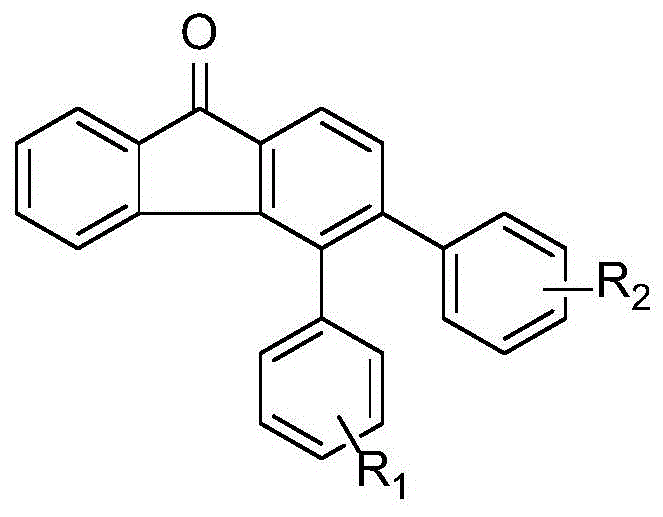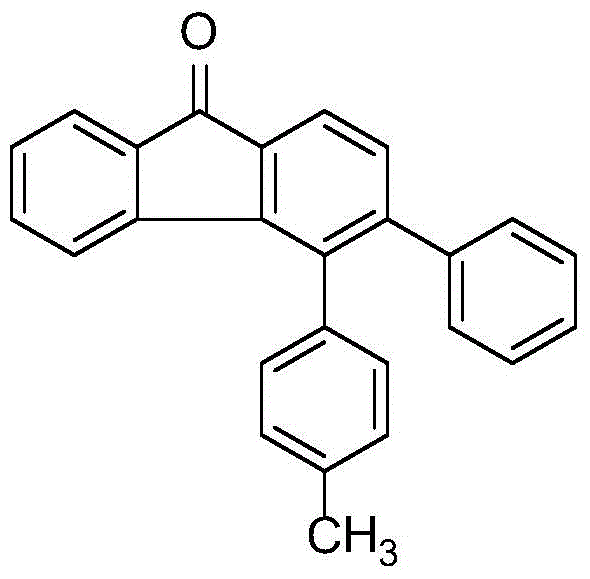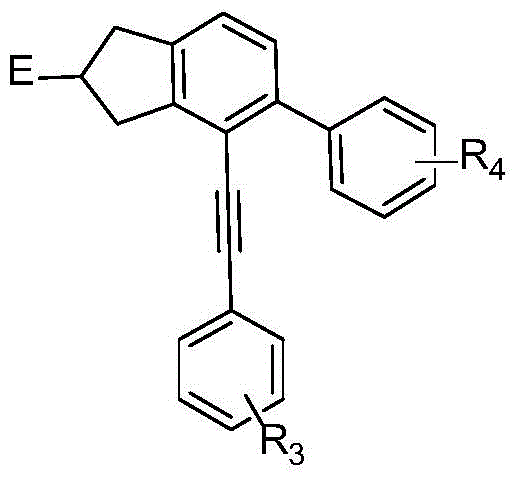Fluorenone derivative, preparation method of fluorenone derivative and redox method of synthetic fluorenone
A derivative, fluorenone technology, applied in the field of redox of tetrayne and polyene alkyne, can solve the problems of many steps, difficult separation and purification, etc.
- Summary
- Abstract
- Description
- Claims
- Application Information
AI Technical Summary
Problems solved by technology
Method used
Image
Examples
Embodiment 1
[0031] A redox method for synthesizing fluorenones from tetraynes and polyenynes.
[0032]
[0033] A kind of fluorenone derivative, the structural formula of described fluorenone derivative is:
[0034]
[0035] R 1 , R 2 is hydrogen, straight-chain alkyl, branched-chain alkyl, halogen, alkoxy and their corresponding derivatives.
[0036] A kind of condensed ring aromatic hydrocarbon derivative, its structural formula is:
[0037]
[0038] The E=CO 2 R; R is straight-chain alkyl, branched-chain alkyl, etc., saturated hydrocarbons, unsaturated hydrocarbons and aromatic hydrocarbon groups. R 3 , R 4 is hydrogen, alkyl, halogen, alkoxy and their corresponding derivatives.
[0039] The structural formula of fluorenone derivatives is:
[0040]
[0041] The R 1 is methyl, R 2 for hydrogen.
[0042] It is a fluorenone derivative obtained from tetrayne and polyenyne through redox method.
[0043] The preparation method of fluorenone derivative comprises the fo...
Embodiment 2
[0052] In the preparation method, step a, precursor synthesis, includes the following steps:
[0053] (1) With sodium hydride as a catalyst, diisopropyl malonate and propargyl bromide were added to anhydrous acetonitrile in an ice-water bath, stirred and reacted for 8 hours, the product was washed with water, extracted with ethyl acetate, and spin-dried under reduced pressure , column chromatography (volume ratio ethyl acetate:petroleum ether=1:100) to obtain a white solid product, namely compound 1, wherein the molar ratio of diisopropyl malonate to propargyl bromide is 1:2.2-3.2;
[0054] (2) Mix compound 1 with phenylethynyl bromide in Pd(PPh 3 ) 2 Cl 2 / CuI anhydrous and oxygen-free catalytic system, using triethylamine as the base, anhydrous acetonitrile as the solvent, stirred and reacted at room temperature for 12 hours, the product was washed with water, extracted with ethyl acetate, spin-dried under reduced pressure, and column chromatography (Volume ratio ethyl ac...
Embodiment 3
[0060] A fluorenone derivative, the structural formula of the fluorenone derivative is:
[0061]
[0062] A kind of preparation method of fluorenone derivative, described preparation method comprises the following steps:
[0063] a. Precursor synthesis;
[0064] b. Synthesis of the target product;
[0065] c. Purification.
[0066] Wherein, a, precursor synthesis, comprises the following steps:
[0067] (1) Using sodium hydride as a catalyst, add 200mmol diisopropyl malonate and 440mmol propargyl bromide to an ice-water bath in anhydrous acetonitrile, stir and react for 8 hours, wash the product with water, extract with ethyl acetate, and depressurize Spin to dry, column chromatography (volume ratio ethyl acetate:petroleum ether=1:100) to obtain a white solid product, namely compound 1;
[0068]
[0069] (2) Mix 80mmol compound 1 with phenylethynyl bromide in Pd(PPh 3 ) 2 Cl 2 / CuI anhydrous and oxygen-free catalytic system, the molar ratio Pd(PPh 3 ) 2 Cl 2 : ...
PUM
 Login to View More
Login to View More Abstract
Description
Claims
Application Information
 Login to View More
Login to View More - Generate Ideas
- Intellectual Property
- Life Sciences
- Materials
- Tech Scout
- Unparalleled Data Quality
- Higher Quality Content
- 60% Fewer Hallucinations
Browse by: Latest US Patents, China's latest patents, Technical Efficacy Thesaurus, Application Domain, Technology Topic, Popular Technical Reports.
© 2025 PatSnap. All rights reserved.Legal|Privacy policy|Modern Slavery Act Transparency Statement|Sitemap|About US| Contact US: help@patsnap.com



